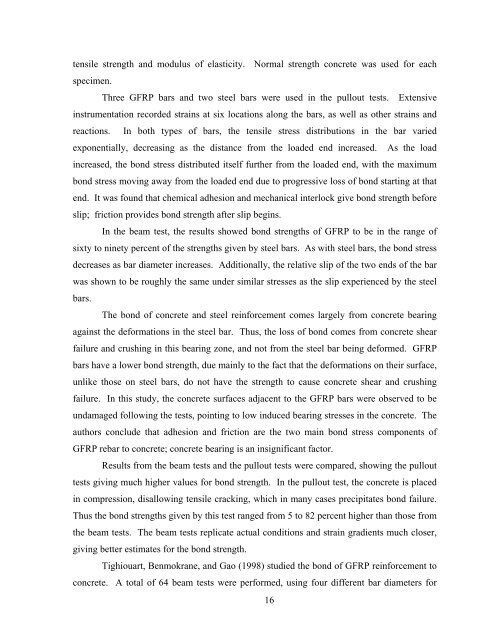Steel Free Hybrid Reinforcement System for Concrete Bridge Decks ...
Steel Free Hybrid Reinforcement System for Concrete Bridge Decks ...
Steel Free Hybrid Reinforcement System for Concrete Bridge Decks ...
You also want an ePaper? Increase the reach of your titles
YUMPU automatically turns print PDFs into web optimized ePapers that Google loves.
tensile strength and modulus of elasticity. Normal strength concrete was used <strong>for</strong> each<br />
specimen.<br />
Three GFRP bars and two steel bars were used in the pullout tests. Extensive<br />
instrumentation recorded strains at six locations along the bars, as well as other strains and<br />
reactions. In both types of bars, the tensile stress distributions in the bar varied<br />
exponentially, decreasing as the distance from the loaded end increased. As the load<br />
increased, the bond stress distributed itself further from the loaded end, with the maximum<br />
bond stress moving away from the loaded end due to progressive loss of bond starting at that<br />
end. It was found that chemical adhesion and mechanical interlock give bond strength be<strong>for</strong>e<br />
slip; friction provides bond strength after slip begins.<br />
In the beam test, the results showed bond strengths of GFRP to be in the range of<br />
sixty to ninety percent of the strengths given by steel bars. As with steel bars, the bond stress<br />
decreases as bar diameter increases. Additionally, the relative slip of the two ends of the bar<br />
was shown to be roughly the same under similar stresses as the slip experienced by the steel<br />
bars.<br />
The bond of concrete and steel rein<strong>for</strong>cement comes largely from concrete bearing<br />
against the de<strong>for</strong>mations in the steel bar. Thus, the loss of bond comes from concrete shear<br />
failure and crushing in this bearing zone, and not from the steel bar being de<strong>for</strong>med. GFRP<br />
bars have a lower bond strength, due mainly to the fact that the de<strong>for</strong>mations on their surface,<br />
unlike those on steel bars, do not have the strength to cause concrete shear and crushing<br />
failure. In this study, the concrete surfaces adjacent to the GFRP bars were observed to be<br />
undamaged following the tests, pointing to low induced bearing stresses in the concrete. The<br />
authors conclude that adhesion and friction are the two main bond stress components of<br />
GFRP rebar to concrete; concrete bearing is an insignificant factor.<br />
Results from the beam tests and the pullout tests were compared, showing the pullout<br />
tests giving much higher values <strong>for</strong> bond strength. In the pullout test, the concrete is placed<br />
in compression, disallowing tensile cracking, which in many cases precipitates bond failure.<br />
Thus the bond strengths given by this test ranged from 5 to 82 percent higher than those from<br />
the beam tests. The beam tests replicate actual conditions and strain gradients much closer,<br />
giving better estimates <strong>for</strong> the bond strength.<br />
Tighiouart, Benmokrane, and Gao (1998) studied the bond of GFRP rein<strong>for</strong>cement to<br />
concrete. A total of 64 beam tests were per<strong>for</strong>med, using four different bar diameters <strong>for</strong><br />
16

















